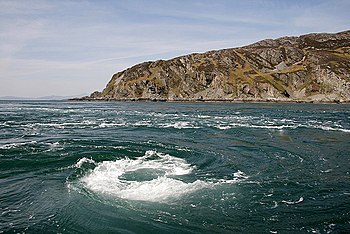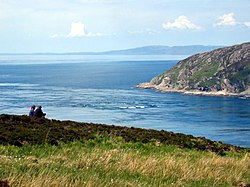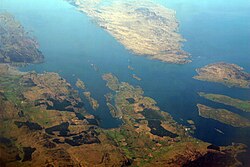Gulf of Corryvreckan


The Gulf of Corryvreckan, also called the Strait of Corryvreckan, is a narrow strait between the islands of Jura and Scarba amongst the Inner Hebrides, off the Argyllshire coast. It is famous for the great whirlpool which forms here, the Corryvreckan.
The name of the channel is taken from its whirlpool, this name is from the Gaelic Coire Bhreacain meaning "Cauldron of the Speckled Seas" or "Cauldron of the Plaid",
It is possible for tourists to visit these waters by way of boat trips from local harbours or sightseeing flights from Oban Airport.
The Corryvreckan and the tides
The Corryvreckan is the third-largest whirlpool in the world, and forms on the northern side of the gulf, surrounding a pyramid-shaped basalt pinnacle that rises from depths of 230 feet at the seafloor to 95 feet at its rounded top. Flood tides and inflow from the Firth of Lorn to the west can drive the waters of Corryvreckan to waves of more than 30 feet, and the roar of the resulting maelstrom can be heard ten miles away.
Strong Atlantic currents and unusual underwater topography conspire to produce a particularly intense tidal race in the Corryvreckan channel, and this is what creates the whirlpool: as the flood tide enters the narrow area between Jura and Scarba it speeds up to 8.5 knots, and also meets a variety of seabed features including a deep hole and the rising pinnacle around which the Corywreckan forms. These features combine to create whirlpools, standing waves and a variety of other surface effects.
The strait is not classified by the Royal Navy as unnavigable but the 'West Coast Pilot' reports it as "very violent and dangerous" and says "no vessel should then attempt this passage without local knowledge"). The nearby Grey Dogs, or Little Corryvreckan, are classified as unnavigable.[1]
Experienced scuba divers who have explored the waters have described it as "potentially the most dangerous dive in Britain".[2]
Mythology


In mythology the hag goddess of winter, Cailleach Bheur, uses the gulf to wash her great plaid, and this ushers in the turn of the seasons from autumn to winter. As winter approaches, she uses the gulf as her washtub, and it is said the roar of the coming tempest can be heard from as far away as twenty miles, lasting for a period of three days. When she is finished with the washing, the cloth is pure white, and becomes the blanket of snow that covers the land.[3]
Another legend surrounds Norse king Breacan. In various stories, Breacan moored his boat near the whirlpool to impress a local princess, or alternatively to flee from his father across the gulf. In both stories Breacan was swept into the whirlpool, and his body dragged ashore later by his dog. Breacan may be named after the whirlpool, or its current name may be a Gaelic pun on his name.
The gulf is also inhabited by the Blue men of the Minch, "the fiercest of the Highland storm kelpies", according to Alasdair Alpin MacGregor.[4]
History
Writing in the 7th century Adamnan called Corryvreckan "Charybdis Brecani".
In 1549, Dean Monro wrote of "Skarbay" that between it and "Duray":
"ther runnes ane streame, above the power of all sailing and rowing, with infinit dangers, callit Corybrekan. This stream is aught myle lang, quhilk may not be hantit bot be certain tyds."[5]
In 1820 the world's first passenger paddleship the PS Comet was wrecked nearby to Craignesh Point as a result of encountering the strong currents.
In mid-August 1947, the author George Orwell and his son nearly drowned in the Corryvreckan whirlpool.[6][7] Seeking to focus his main energies on completing a novel destined to become the dystopian classic Nineteen Eighty-Four, Orwell had fled the distractions of London in April 1947 and taken up temporary residence at Barnhill on the isolated island of Jura.
On the return leg of an August boating daytrip to nearby Glengarrisdale, Orwell seems to have misread the local tide tables and steered into rough seas that drove his boat near to the whirlpool. When the boat's small engine suddenly sheared off from its mounts and dropped into the sea, Orwell's party resorted to oars and was saved from drowning only when the whirlpool began to recede and the group managed to paddle the distressed craft to a rocky outcrop about a mile distant from the Jura coastline. The boat capsized as the group tried to disembark, leaving Orwell, his two companions, and his three-year-old son stranded on the uninhabited outcrop with no supplies or means of escape. They were rescued only when passing lobstermen noticed a fire the party had lit in an effort to keep warm.[8]
Orwell completed a first draft of Nineteen Eighty-Four about three months after the Corryvreckan incident, with the final manuscript not finished until late 1948.
Natural history
Minke whales and porpoises swim in the fast-moving waters and only the most resilient plants and corals thrive on the seabed. Soft corals such as Alcyonium digitatum can be found in hollows and other sheltered locations. The central pinnacle supports dense mats of the hydroids Tubularia indivisa and Sertularia cupressina and the bryozoan Securiflustra securifrons. The most exposed areas are covered by the barnacles Balanus crenatus and B. hameri.[9]
The area is currently being considered for Special Area of Conservation status.
Modern cultural references
Part of Powell's and Pressburger's 1945 film I Know Where I'm Going! was set at Corryvreckan. They filmed in Corryvreckan and the nearby (but less fierce) waters at Bealach a' Choin Ghlais ("the pass of the grey dog"). The footage obtained there was then used in back projections with the actors in a replica boat rocked on gimbals while buckets of water were thrown at them. Model shots of the whirlpool were made to give a medium view of the boat being drawn into Corryvreckan.
Ardbeg Distillery produced a limited edition "Ardbeg Corryvreckan Scotch whisky" in 2008.
The McCalmans have recorded a song called Corryvreckan Calling.[10]
Outside links
References
- ↑ :"Passage conditions 7.260 – It is reported that the excessive rate of the tidal stream and the narrow width of the E entrance channel create an unnavigable area just S of Eilean a' Bhealaich, an islet in the centre of the E entrance. As a result, it is inadvisable to pass through this channel, and even with local knowledge passage should only be attempted in quiet weather at slack water.'" - The West Coast of Scotland Pilot
- ↑ Rogerson, Simon (1 March 2003). "Diving: Perfect places to take the plunge". The Daily Telegraph. http://www.telegraph.co.uk/travel/726986/Diving-Perfect-places-to-take-the-plunge.html. Retrieved 22 December 2010.
- ↑ McNeill, F. Marian (1959), The Silver Bough, Vol.2: A Calendar of Scottish National Festivals, Candlemas to Harvest Home, William MacLellan, pp. 20–21, ISBN 0-85335-162-7
- ↑ MacGregor, Alasdair Alpin (1937), The Peat-fire Flame, Moray Press, https://archive.org/stream/peatfireflamefol00macg#page/117/mode/1up
- ↑ Monro (1594) "Skarbay" No. 16. Translation from Scots: "there runs a [tidal] stream, above the power of all sailing and rowing, with infinite dangers, called Corybrekan. This stream is eight miles long, and may not be frequented but at certain tides."
- ↑ "The masterpiece that killed George Orwell" The Observer. 10 May 2009
- ↑ Taylor, D.J. (2003). Orwell: The Life. London: Chatto & Windus. pp. 385–7.
- ↑ Taylor, Supra.
- ↑ Wilding, T. A., Hughes, D. J. and Black, K. D. (2005)"The benthic environment of the North and West of Scotland and the Northern and Western Isles: sources of information and overview." (pdf) Report 1 to METOC. Oban. Scottish Association for Marine Science.
- ↑ "Lyrics – Corryvreckan Calling". the-mccalmans.com. Retrieved 5 June 2011.